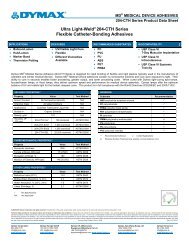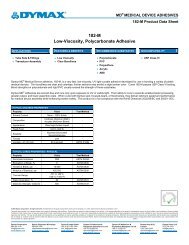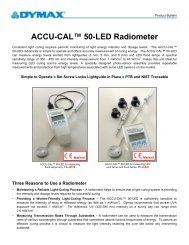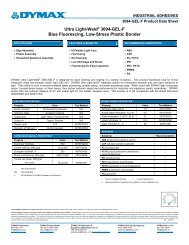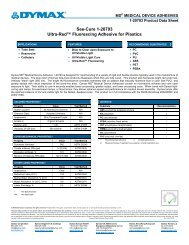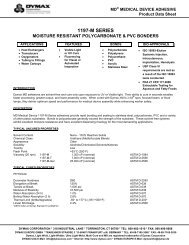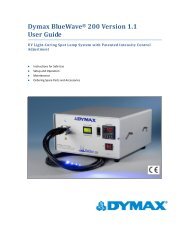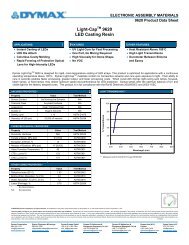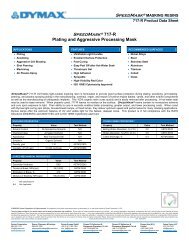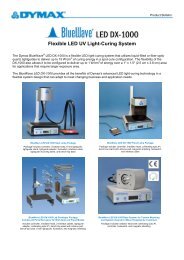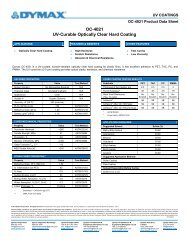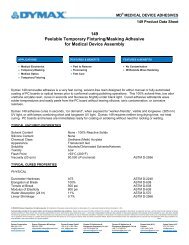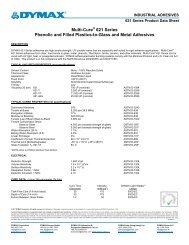Aerobic Adhesives VII – A New High Performance Bonding Option ...
Aerobic Adhesives VII – A New High Performance Bonding Option ...
Aerobic Adhesives VII – A New High Performance Bonding Option ...
Create successful ePaper yourself
Turn your PDF publications into a flip-book with our unique Google optimized e-Paper software.
Cyanoacrylates (CA’s)<br />
Rigid and brittle CA’s (superglues) cure in seconds upon contact with the moisture that is naturally absorbed on<br />
almost all surfaces. Some plastics require priming. Many CA’s effloresce on cure, resulting in a “frosting” effect<br />
that can effect both appearance and the clarity of optical components. Though depending on it for cure, CA<br />
bond lines are quite sensitive to and degrade with exposure to too much moisture. Most CA bonds are not shock<br />
resistant.<br />
IV UV/Visible <strong>Aerobic</strong> Acrylic Adhesive’s - Composition and Curing<br />
UV curable acrylates are comprised of oligomers, monomers, additives, and photoinitiators. These formulations<br />
can be tailored to provide optically clear resins with specific refractive indexes, adhesion, weatherability,<br />
resistance to UV light, etc. Oligomers are medium length polymer chains that contribute to tensile strength,<br />
modulus, and elongation. Monomers provide adhesion to different substrates. Additives can provide a wide<br />
range of viscosities to allow for easier dispensing, or can be incorporated as fillers for extremely low shrinkage.<br />
Figure 6. Typical UV-Curing Urethane Acrylate Adhesive<br />
TYPICAL UV-CURING<br />
URETHANE ACRYLATE ADHESIVE<br />
UV/VIS<br />
Light<br />
P.I.<br />
ADDITIVE<br />
for fine tuning<br />
MONOMER<br />
for specific properties<br />
OLIGOMER<br />
for basic properties<br />
Photoinitiator<br />
The UV adhesives cure upon exposure to UV light in the 300-400 nm range of the electromagnetic spectrum as<br />
shown below in Figure 8. UV/visible light curing adhesives cure in the 300-500 nm range, which allows for curing<br />
to deep sections, faster cures, or cure through UV blocked substrates. Using a visible light curing adhesive also<br />
allows for faster cures using a lower intensity, low power light source, an advantage when considering the cost of<br />
light sources.<br />
All light curing formulations include, in addition to the basic resin chemical constituents, oligomers, monomers,<br />
thickeners, adhesion promoters, etc. Photoinitiators that react when exposed to light of the correct wavelengths<br />
cause polymerization of the resins. These photoinitiators are organic molecules which can absorb light and<br />
produce radical species upon splitting. It is these radicals that initiate the polymerization of the monomers and<br />
meth(acrylate) oligomers. See figure 2 for reaction mechanism. Adhesion is developed by secondary reactions<br />
with adhesion promoters directly to the Silicone atoms in the glass within 1-60 minutes to gain a 10-200%<br />
increase in compression strength.<br />
Figure 7 - Free Radical Initiation, Propagation, And Termination/Adhesion to Glass surface<br />
Initiation UV Light<br />
UV<br />
M PI<br />
PhotoInitiator<br />
M M<br />
M Molecule<br />
M M<br />
PI<br />
Propogation<br />
UV<br />
M<br />
PI<br />
M<br />
M<br />
M<br />
M<br />
PI<br />
PI<br />
M<br />
M<br />
Termination - Full Cure<br />
Si-O-Si-O-Si-O-Si-O-Si Si-O-Si-O-Si-O-Si-O-Si Si-O-Si-O-Si-O-Si-O-Si-O<br />
M<br />
M<br />
M<br />
M<br />
M<br />
M<br />
M<br />
M<br />
M<br />
M



